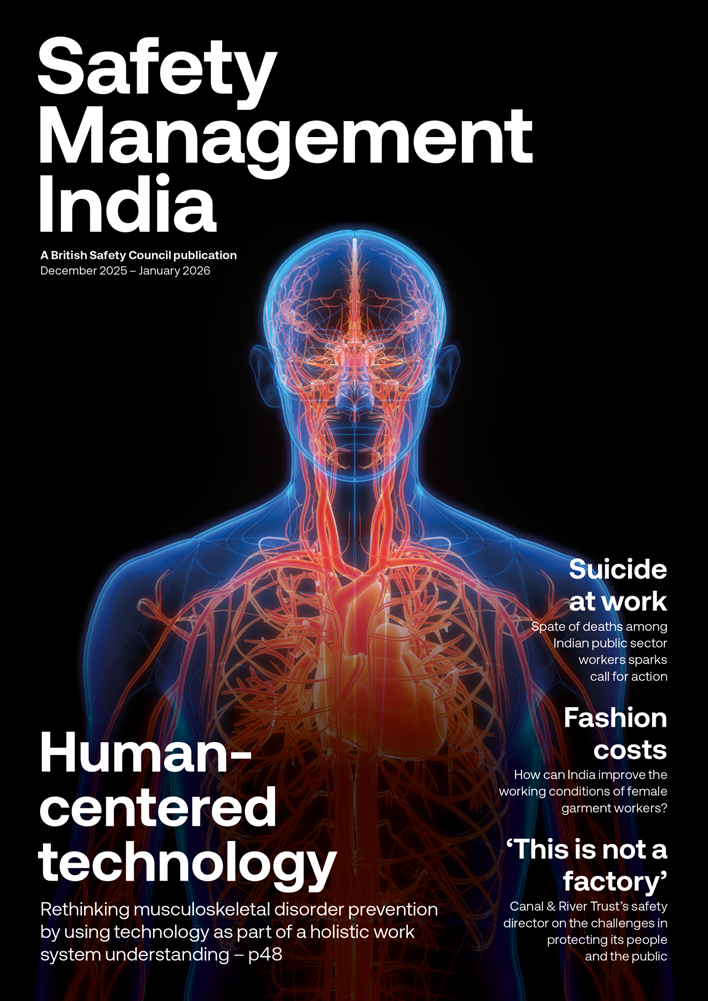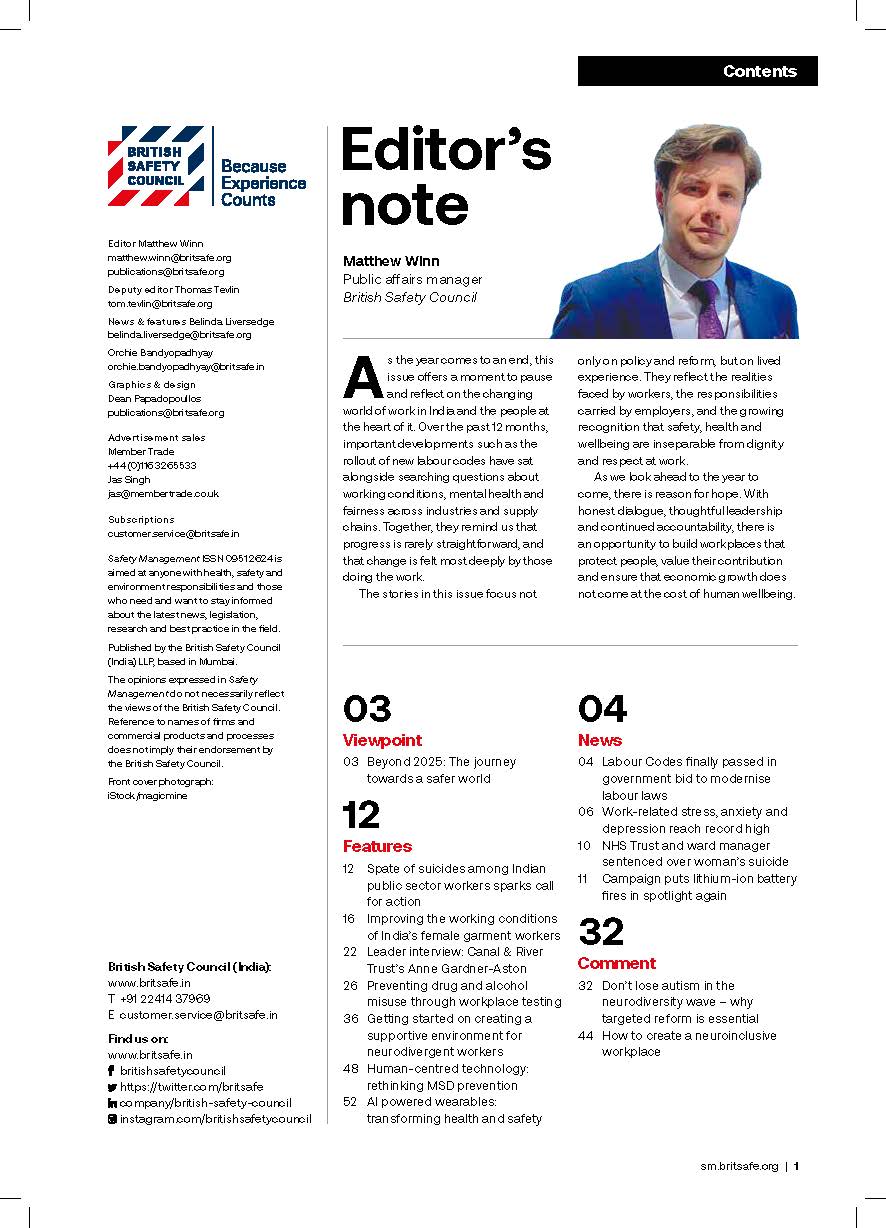With UK fire services now tackling at least three Li-ion battery fires a day, it’s clear that stronger regulation and enforcement is urgently required to prevent the sale, use and modification of poor-quality and potentially dangerous batteries used in e-bikes and scooters.
Features
The hidden risks of lithium-ion batteries
Lithium-ion (Li-ion) batteries are an everyday feature of modern life. They power our smartphones, laptops, power tools, industrial machinery, and increasingly, our transport, from e-bikes and e-scooters to electric vehicles (EVs). Driven by a shift towards sustainability, businesses and individuals alike are adopting Li-ion battery-powered solutions. There is no doubt that this transition towards Li-ion battery devices is aimed at making life easier; however, many users are unaware of the fire risk Li-ion batteries pose.
When used and stored normally, Li-ion batteries are stable and function as intended. The vast majority of battery devices and vehicles fall into this category. Problems arise, though, when they are damaged, misused, charged or stored incorrectly. Li-ion batteries are particularly sensitive to high temperatures, cold temperatures, over-charging and over-discharging.
If a battery unit has been damaged by an event such as dropping, piercing or even heavy jolting, it can trigger an internal fault. This can cause an electrical short circuit which triggers a process called ‘thermal runaway’ where batteries start to irreversibly overheat. The result can be a sudden, violent, explosive fire that burns very differently from a conventional combustion fire.
 When used and stored normally, Li-ion batteries are stable and function as intended. Photograph: iStock
When used and stored normally, Li-ion batteries are stable and function as intended. Photograph: iStock
Compared to other types of fires, Li-ion fires become explosive very quickly once thermal runaway starts, generating torch-like flames that can spread the fire to the surroundings faster and further. EV fires can last several times longer and take several times more water to extinguish than petrol or diesel engine vehicle fires. Experience shows that when EVs are close to other vehicles or inside buildings, the consequences of fires involving the Li-ion batteries can result in more widespread damage to their surroundings than when Li-ion batteries are not involved. This includes greater risk of harm to the environment and greater risk of serious injury to people, including firefighters.
At QBE, we conducted a Freedom of Information request across UK fire services to understand the scale of the issue – and the results paint a stark picture.
Our research revealed that the number of fires caused by Li-ion batteries almost doubled (93 per cent) in the past two years (2022–2024). This is in line with the increase in numbers of EVs (fully electric and hybrid electric) on the road in the UK in the same period, so not totally unexpected. We should also note that EV fires are much less frequent than petrol and diesel engine vehicle fires. The likelihood of an EV fire is estimated to be between one-fifth to one-twentieth the rate of internal combustion engine (ICE) vehicles and indications suggest only around a quarter of these start on the battery itself.
However, the responses from the UK fire services clearly indicate that they now tackle at least three Li-ion battery fires a day. Due to greater risk of harm and damage, this puts more people and more property at risk more often.
This rate of increase will only continue in the coming years. This means greater awareness, improved fire safety measures, and stronger regulation are urgently needed.
Increased risks in personal transport
E-bikes are a major contributor to almost a third (27 per cent) of all recorded Li-ion battery fires in 2024. Fires linked to electric vehicles (EVs), e-scooters, and mobility scooters have also risen significantly.
Many of these fires stem from uncertified or modified battery systems. Incidents frequently involve incompatible conversion kits, where regular push-bikes are retrofitted with motors and batteries. Other risks include poor-quality battery replacements purchased from unregulated sellers. These uncertified products often lack essential safety features such as overcharge protection or thermal cut-offs.
Without proper certification, it’s difficult to predict how batteries will behave over time – making unmoderated batteries significantly more prone to thermal runaway and fire.
Although it is legal to sell Li-ion batteries for alternative uses (such as bicycle conversions), the onus is on the buyer to ensure the product is compatible and certified. Ideally, batteries should carry a CE or UL mark confirming they meet safety standards. Without proper due diligence, the risk of fire rises considerably.
 E-bikes are a major contributor to almost a third (27 per cent) of all recorded Li-ion battery fires in 2024. Photograph: iStock
E-bikes are a major contributor to almost a third (27 per cent) of all recorded Li-ion battery fires in 2024. Photograph: iStock
In the context of these numbers, it is important to recognise that properly certified, unmodified products that are well maintained, well treated and charged safely are highly unlikely to suffer thermal runaway and fires.
Keeping pace in regulatory updates
As the use of battery-powered devices becomes more common, particularly in consumer transport, the regulatory landscape must evolve to maintain safety. Action is required from key stakeholders, including the UK Government, Office for Product Safety and Standards (OPSS), and online retailers, to reduce preventable Li-ion fires.
Campaigns such as the OPSS’s Buy Safe, Be Safe campaign are a positive step, but the rapid rate of Li-ion battery popularity has seen the market flooded with unregulated and unsafe products. More stringent, enforceable regulation is now essential.
Third-party safety certification, via CE or UL marks, should be mandatory for all Li-ion batteries, especially those used in e-bikes and e-bike conversion kits. Enforcement is more effective when regulators, retailers and consumers can easily identify certified products. Stronger supply chain traceability and tougher penalties for sellers of unsafe batteries must also be prioritised. Robust regulation brings clarity, accountability and traceability throughout the supply chain.
Increased awareness is a priority area
The rapidly growing fire risk associated with Li-ion batteries can only be addressed through improved consumer education and regulation. This is being considered in current legislation, such as the Product Regulation and Metrology Bill. Currently going through Parliament, the Bill includes provision for:
- Mandatory third-party certification for all Li-ion products
- Stronger regulation of Li-ion imports and resale markets
- Legal authority for Trading Standards to remove unsafe products
- Specific enforcement powers.
Without these provisions, existing regulation will be insufficient to prevent the growing wave of incidents involving unsafe batteries and chargers. Government must seize this opportunity to implement comprehensive and enforceable safety measures that protect both people and property.
 There were 232 fires involving an electric car in 2024 according to QBE's research. Photograph: iStock
There were 232 fires involving an electric car in 2024 according to QBE's research. Photograph: iStock
Preventing and fighting Li-ion fires
Even with regulation in place, it remains a shared responsibility to understand and mitigate the fire risks posed by Li-ion batteries. These fires burn hotter and faster than conventional fires, with the potential to cause serious damage to property and people.
To reduce the risk (or limit the damage if a fire does occur) several precautions are recommended:
- Batteries should only be charged in fire-rated, non-combustible spaces with proper ventilation and spacing
- If charging indoors, smoke or heat detectors must be installed, and devices kept at least four metres from any combustible materials
- Circuit breakers should be fitted, and charging should ideally take place during working hours.
- Storing or charging batteries in escape routes (such as stairwells or corridors) should also be avoided where possible, particularly in multi-occupancy residential buildings.
- In high-risk environments, infrared thermography can be used to detect overheating batteries before a fire begins.
For businesses accepting returned devices, the batteries attached to those devices or enclosed in the packaging should be treated and processed as higher risk. Damage sustained during use or transit may have compromised the stability of the cells.
Enhanced inspection protocols, such as using handheld hot-spot detection cameras as well isolating storage of batteries away from other hazards, should be prioritised. Awareness, training and investment in proper infrastructure are key to mitigating these risks. Li-ion fires behave differently, and the approach to managing them must reflect this.
Advice for consumers
Consumers also play a vital role. Safe habits begin with safe purchases:
- Always buy certified products from reputable retailers
- Look for CE or UL marks on batteries and chargers
- Always use the charger provided by the manufacturer.
At home, avoid charging devices in bedrooms, hallways or near soft furnishings; instead, opt for kitchens or garages equipped with working smoke detectors. Never leave batteries charging overnight or unattended and always unplug them once charging is complete.
If a device has been dropped or damaged, especially if the battery appears swollen or emits a strong odour, then the device should be removed from the building immediately and the battery replaced if possible.
Damaged batteries significantly increase the risk of fire and should be disposed of through certified recycling services.
Education is essential. Without it, the dangers are far greater because the risks won’t be recognised by users. But with informed choices and a few simple precautions, both consumers and businesses can reduce the risk of Li-ion battery fires and continue to benefit safely from this powerful technology.
For more information, visit:
qbeeurope.com/risk-solutions
Read QBE Europe’s most recent report on Li-ion battery use risk:
Li-Ion batteries: increased adoption, overlooked risks
Learn more about the risks posed by Li-ion batteries:
10 ways to mitigate risk in use and storage of lithium-ion batteries
Batteries on borrowed time
E-bikes and e-scooters – what’s the fire risk?
Eight ways to mitigate health risks in relation to Li-ion batteries
Adrian Simmonds is Practice Leader at QBE Europe
FEATURES

The price of fast fashion is not pretty
By Orchie Bandyopadhyay on 11 December 2025
The largely female workforce in India’s garment manufacturing industry faces long hours, low wages and poor working conditions, and campaigners say it is time the Indian government and international clothing brands took tougher action to improve working conditions, pay and employment rights.

Suicide at work: a major problem in India
By Orchie Bandyopadhyay on 11 December 2025
Recent reports of suicides among workers ranging from police officers to electoral roll officials have prompted calls for employers and government agencies to do more to both reduce excessive workloads and provide better mental health support at work.



